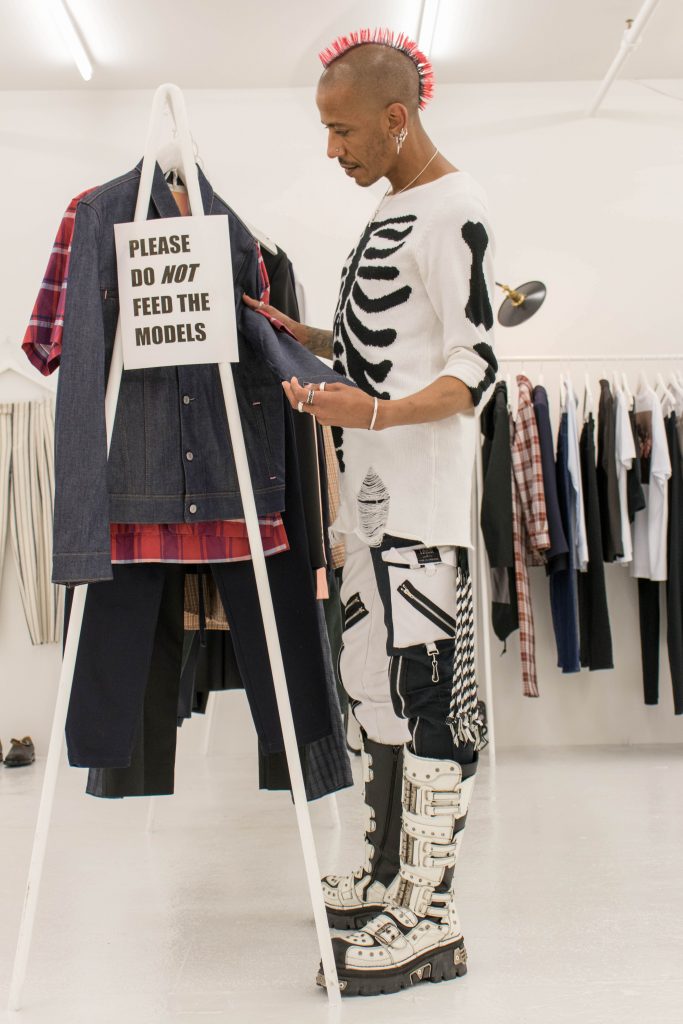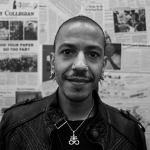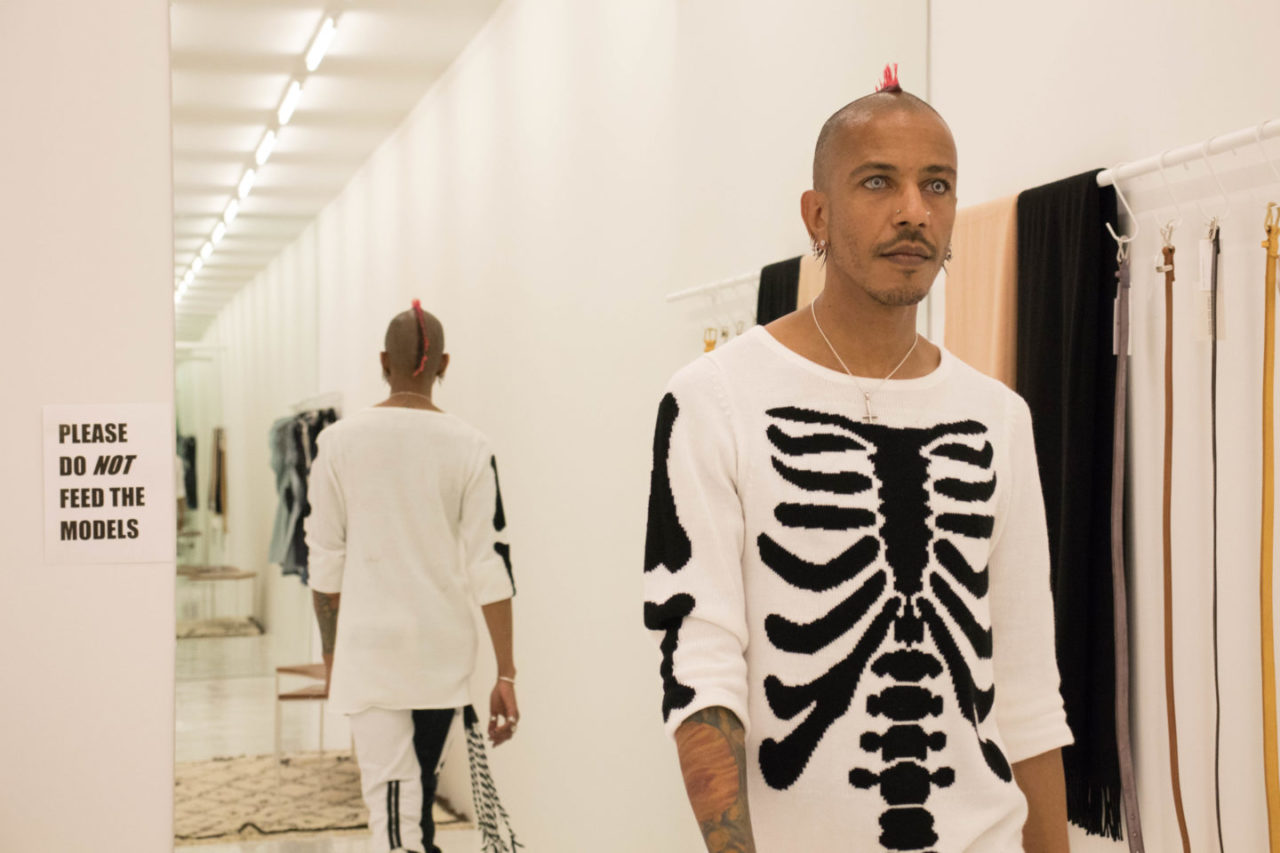“People have told me about organized crime in the fashion industry, but I can’t talk about that. I’m looking to stay alive.”
– Calvin Klein
In 1998, at the tender and awkward age of 18, I was approached by a young woman who represented a modeling agency. She said I had the “it factor” her agency was looking for along with a fierce natural strut that couldn’t be taught (I’ll take that, thank you). She gave me her business card and encouraged me to get headshots taken and sign with her agency. Being the savvy, headstrong, and mistrustful brat that I am, I dismissed her offer as a scam to steal my hard-earned dollars by boosting my ego and told her where she could stick her headshots. I started to walk away, nose pointed at the heavens. She laughed at me, said she “liked my pluck,” and that her agency would pay for my headshots. I reconsidered her for a moment and decided to listen to her proposal. I should have listened to my first instinct. Cue the foreshadowing….
A month later, I found myself in Florence, Italia, walking the runway at Fortezza da Basso. From there, I worked my way into the industry and began strutting the catwalks of Fashion Weeks across the globe. I quit my job, and the whirlwind life of a runway model became my reality. Boom. I got to travel regularly to exotic locales, be in magazines and on billboards, wear expensive clothing (and keep some of it), and good lord was I getting PAID! I felt like a jet-setting baller, and I was on top of the world. Sounds like a dream, right? It certainly seemed that way at first, but the illusion quickly faded. Once I got to do more than take a peek behind the curtain, I quickly realized I was in way over my naive little head.
I realize that using the word naïve to refer to an 18-year-old seems like it goes without saying. In this case, however, my naivety ran deeper than usual. My lack of exposure to the world was more pronounced than it is for most. I had been homeschooled since elementary school with almost no outside socialization, I was heavily abused and impoverished, and I was newly escaped from the clutches of a wildly evangelical and homophobic church, having just come out of the closet and been kicked out of said church for being gay. It was, in reality, a cult.
Before this, the church had been everything to me. My entire social circle revolved around the church and its teachings, and I had no sense of the workings of adult society beyond its walls. I was fresh meat, and utterly clueless. I had no idea who I was without the rules and control of the church. Its leaders had just performed an involuntary and traumatic exorcism on me earlier that month (which obviously failed), and I was still reeling from the experience; overwhelmed and awestruck by the carnal wonders of the big, scary world beyond the church’s confines. I was impressionable, desperate to belong and easily taken advantage of. I was the sucker born one minute ago. My ignorance mingled with insatiable curiosity, and this caustic mixture gave me a thirst for mischief that would make you cover your children’s ears and eyes. This got me into all sorts of trouble. I wanted to try everything at least twice. And so I did. And it all started with my modeling career.
Doing copious amounts of cocaine with Kate Moss was a life goal of mine. Bucket list, check. Photo shoot at the Eiffel Tower? Check. Playing with hot men in the VIP section of the backroom at KitKatClub in Berlin, twice? Check.
Making more money in a month than I had during the entirety of my previous life? Well, you get the idea.
But being a professional model is a soul-sucking endeavor. It drains you of your identity and your will. I was treated like cattle. I was told where to stand, what to wear, what to do. I was poked and prodded, judged and demeaned. I was just an object; to be sexualized, used, and discarded on the whim of the designers and stylists. There’s also a strong chance that you’ll become a drug addict. It is a fake, vicious world, full of plastic people selling plastic garbage to other plastic people. One day you’re in, and the next you’re out. You have to kiss the right asses and play the right games. I was so eager, and so naïve to the inner workings of the industry, that I didn’t realize I was being mistreated until it was too late.
I began to hate these people. I was not like them at all, and I didn’t want to be. I felt as though the industry was changing me for the worse; that I was becoming a disingenuous person just like them. I was a sell-out. And so, over time, I withdrew from the model social circles, tolerating them only when I had to. I began to lead a double life: playing their games to get paid, so I could go off and spend their money on the things that made me happy.
Here’s the thing: I got into the industry at a time when Alexander McQueen was just beginning to make what is now an indelible mark on the fashion industry. Alternative was in, edgy was everything, and that meant hiring models that look like me. Ethnic and gay-erotic representation and imagery were getting their foot in the door, and everyone wanted models who were unique, rebellious, and controversial. Thanks, Madonna. Her hypersexual, androgynous, homoerotic, and ethnocentric imagery in the music video for Justify My Love inspired a whole new era in the fashion industry (Dolce & Gabbana even designed her costumes for the corresponding tour, The Girlie Show). I am nothing if not all of that, and so I was well-received by those with the power to make such decisions as who and what is “in.” The whole thing took off, and designers who had been known for their white-bread and barely-veiled Anglo-centric campaigns began to look for “token” gay, alternative, androgynous men of color for their collections. The designers themselves, however, are still racist pigs underneath the fact that they caved into the pressures of the day, and so working for them proved to be… unpleasant. Much goes on in the fashion industry that has already come to light and doesn’t need any help in being exposed, so I will gloss over those things for now. But we’ll come back to that business later.
As I said before, I was swinging from the rafters, and loving every sinful minute of it. Along this fantastical journey of mine, I got heavily into cocaine and ecstasy, which is so cliché, I know. When models can’t eat, what else are they supposed to do? Don’t judge me. I’m perfect. But seriously– here’s where it gets really dark and really scary.
Even though I stopped hanging out in fashion circles by day, I still went to all the parties. It’s what you did, and it’s where all the juicy stuff happened. Because I was a “bad kid,” a druggie, and a general party animal, there were certain assumptions made about me that were not true. One of those assumptions was that my moral compass pointed to the South Pole. If you hang out long enough with these people, going to sketchy parties and doing mountains of drugs, they think you are down for whatever. Hookers and blow really do go hand-in-hand, and Rick James said it best: “cocaine is a helluva drug.” And that was by far the least ominous of the chemicals and activities present at these underground gatherings.
I witnessed lots of distasteful shit go down. I didn’t realize at the time that many of the participants in the goings-on were not as willing as I had thought. Some of them were there under less than consensual conditions. Many of them weren’t even legal. I’m talking 16-year-olds tied down and drugged up in the basement, and I’m sure you know what happens to them. I didn’t know any better yet. I was so self-absorbed that I just assumed everyone was having a good time, like me. If I had known enough to stay away, what happened next would be just another dramatic Lifetime channel special to me.

I was approached on several occasions by various photographers and stylists with propositions of money for “services rendered” (yes, I mean sex), or to become a coke mule; often these offers were in tandem. It was less than comfortable regardless of the setting. I was told that this was the nature of the business, and if I wanted to get ahead, I either needed to become a prostitute or a drug trafficker on the side. As part of that deal, I would be expected to put out for certain designers, photographers, and stylists whenever they pleased. Passed around like a photograph. In exchange, I would make a ton of extra money, and assure my longevity in the industry. Often this happened at parties, but often “at work” as well, in front of other people. They seemed utterly shocked when I emphatically and disgustedly said no, as if I were a sure thing. A few of these proposers also tried to force themselves on me, confident enough in their standing and power that when I threatened to expose them, they merely smiled. Clearly, this had happened many times before with no retribution, and they were unafraid. Some of you may feel that I was merely treated as I ought to have been, and you are welcome to that opinion if it suits you.
In my travels, I also began to notice that some of the newer models of foreign origin were disappearing from the model houses, especially the ones who did not speak or understand English well. I was inadvisably nosy and did some snooping around. It turns out that some of these industry people were also human traffickers, mostly “model scouts” who were, shall we say, less than legitimate. The girls (and boys) were being sold for nefarious purposes, never to be seen again, and lots of people knew about it—more than I would have guessed. They were all on the take, and no one cared at all. Have you ever seen the movie Hostel, by Eli Roth? That shit actually happens, except the end game is not to murder you in an abandoned warehouse. It’s close enough, though. I. Was. Horrified. In my ignorant confidence, I thought I could take on this appalling international ring of organized crime. I was wrong.
What I had failed to realize is that the fashion industry is very tightly-knit and very powerful. These people run the world, the amount of backscratching they do is absurd, and they get away with some truly unsavory politics, maneuvering, and criminal activity that would shock the layman. I had challenged the wrong structure. I was blackballed so fast it made my head spin. The network they had created was unbreakable, and the doors I had grown accustomed to prancing through were now slammed in my face and dead-bolted. Everyone I turned to for help turned a blind eye. I tried to sue and break the contract and was counter-sued. I tried to report it to the police, and the reports went missing. I was even followed, roughed up, and harassed–which is quite frightening on foreign soil. I was silenced and powerless. I was off the guest list.
I can only guess that in this case, like in so many others, money can cover up anything and everything. In fact, that’s how “they” got rid of me. Using intimidation tactics, they bought out (broke) my contracts for a hefty sum to shut me up, told me I would never work in the industry again, destroyed my portfolios, all of my work disappeared, and suddenly no agency had ever heard of me. I had signed confidentiality agreements as part of my contracts, and so I was not allowed to “defame” the professionals I was trying to blow the whistle on, and I had no proof to back me up. The internet and smartphones weren’t a thing yet, and so acquiring evidence was near impossible unless you had a willing news crew or a P.I. at your disposal, which I did not… I was labeled a liar and discredited by those in power. In a fashion very similar to what happened to Rose McGowan, I was made a pariah by the entire industry, while those that knew the truth looked the other way. If you’ve ever wondered why I have such a staunchly pejorative opinion of the fashion industry, now you know.
I left the fashion industry in disgrace and dismay. I drowned my sorrows in money, drugs, alcohol, and general debauchery for a time, until the money ran out. It took me a long time to come to grips with what had happened. I had challenged the machine, and the machine had won. It was over, I had lost everything, and there was nothing I could do.
Remember that quote up there at the top from CK? What do you think he’s talking about? It’s an actual quote from the horse’s mouth, and I used it for a reason: to make it very clear to you, the reader, that the entirety of the fashion industry is aware of what’s going on, of what I learned. Anna Wintour certainly knew. Alexander McQueen knew, and he was my favorite. He listened to me when I spoke of what I had found, and his advice? “Put your head down and sell the garments.”
Part of me thinks I should have listened to him, but the social justice part of me knows I could never have worked with these vile people, no matter how much money I was making. I now carry the unfortunate burden of knowledge I was never supposed to have. My advice? Never listen to anyone who tells you, you should be a model. Just keep walking. Find your own runway.
Money. Gobs of it. Billions and billions. That’s what these people have, and it’s our fault they have it.
They literally get away with murder; all happily, but blindly, funded by us, the consumers.
If you’re reading this, it should be clear to you that I know from experience that no single person can possibly hope to break through the fortress of fashion.
There is, however, something we can do, every one of us. Pay attention to what you buy, what you wear, from whom, and from where. If you want to know who the bad guys are, you just have to follow the dollar signs. The bigger the company, the fewer scruples they probably have. Let’s go back to supporting small businesses. Invest in the little guys, the ones just like you who sell their goods honestly, and at a fair price. For the love of all the fashion Gods, use the internet to your advantage. There are a plethora of fantastic designers out there that you just haven’t heard of yet. Google that shit, find something you love, and give them your money. Mass-produced goods usually mean exploitation is happening behind the scenes, and somewhere along the way someone is getting hurt. In case you haven’t noticed, the mass-produced crap is exactly that: crap. It will fall apart on you anyway once you wash it twice. So give your money to the true craftsman, the local artisan, the struggling business owner. The ones who haven’t traded quality for quantity, and people for profits. In a small way, it’s the same as saving a life.
In case you were wondering, today I’m sober, and slap-your-mama damn proud of it. Now, I am just another impoverished, struggling citizen. I feel guilty for buying Starbucks and worry about how I’m going to afford to take my dog to the vet. There is nothing very special or glamorous about me. I would have retired from modeling by now no matter what because I am past my prime, I aged poorly (yes, black does crack), and modeling is not a career you can maintain for very long. And here I am, 20 years later, in community college. The best I can do is use my tiny voice to continue to speak out against what I know about the mad circus behind the curtain, in the hopes that, if you are reading this, you will think twice before you buy what they’re selling.
You must decide for yourself what your vanity is worth to you, but others will pay a much greater price. Because somewhere an innocent young boy or girl is being abused, thanks to the excessive money you spent on your Louis Vuitton pumps.
*Astro*
Author

Astro (they/them) is the Editor-in-Chief of the Seattle Collegian, the President of Seattle Central's Queer Cooperative club, a fully-professed Guard with the Sisters of the Mother House of Washington, a social worker and behavioral scientist, founder of Transgender Day of Remembrance at Seattle Central (TDoR), Board Member-At-Large with Diversity Alliance of Puget Sound (DAPS), and a self-identified Queer-Alien-Person-Of-Color. They have won awards for their journalism and community service work as well as for innovation in leadership and academic excellence, and are an active and outspoken advocate and activist for both the LGBTQ+ and recovery communities. They speak regularly at events relevant to these causes, and work closely with their fellows to support these communities. Social justice, diversity, equity and inclusion are their banners, and their belief in the gifts, strengths, and resilience of all minoritized communities is the driving motivation behind their work and their mission: using the powers of journalism, self-expression, creativity, conversation and connection to uplift and foster acceptance for all peoples.






